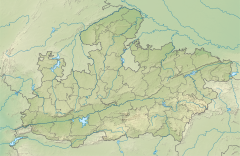
Back سانشي Arabic সাঁচী Assamese Sanchi BAN সাঁচী Bengali/Bangla সঞ্চি BPY Sanchi (jaciment budista) Catalan Санчи CE Sanchi (arkiyolohiyang dapit) CEB Sáňčí Czech Sanĉio Esperanto
| Sanchi | |
|---|---|
 The Great Stupa at Sanchi, Raisen district, MP. | |
| General information | |
| Type | Stupa and surrounding buildings |
| Architectural style | Buddhist, Mauryan |
| Location | Sanchi Town, Raisen district, Madhya Pradesh, India |
| Town or city | Sanchi, Raisen district |
| Country | |
| Construction started | 3rd century BCE |
| Height | 16.46 m (54.0 ft) (dome of the Great Stupa) |
| Dimensions | |
| Diameter | 36.6 m (120 ft) (dome of the Great Stupa) |
| Official name | Buddhist Monument at Sanchi |
| Criteria | Cultural: i, ii, iii, iv, vi |
| Reference | 524 |
| Inscription | 1989 (13th Session) |
| Sanchi stupa was destroyed by Pushyamitra Shunga. | |
23°28′45″N 77°44′23″E / 23.479223°N 77.739683°E Sanchi Stupa is a Buddhist complex, famous for its Great Stupa, on a hilltop at Sanchi Town in Raisen District of the State of Madhya Pradesh, India. It is located, about 23 kilometers from Raisen town, district headquarter and 46 kilometres (29 mi) north-east of Bhopal, capital of Madhya Pradesh.
The Great Stupa at Sanchi is one of the oldest stone structures in India, and an important monument of Indian Architecture.[1] It was originally commissioned by the Mauryan emperor Ashoka the Great in the 3rd century BCE. Its nucleus was a simple hemispherical brick structure built over the relics of the Buddha. It was crowned by the chatra, a parasol-like structure symbolising high rank, which was intended to honour and shelter the relics. The original construction work of this stupa was overseen by Ashoka, whose wife Devi was the daughter of a merchant of nearby Vidisha. Sanchi was also her birthplace as well as the venue of her and Ashoka's wedding. In the 1st century BCE, four elaborately carved toranas (ornamental gateways) and a balustrade encircling the entire structure were added. The Sanchi Stupa built during the Mauryan period was made of bricks. The composite flourished until the 11th century.
Sanchi is the center of a region with a number of stupas, all within a few miles of Sanchi, including Satdhara (9 km to the W of Sanchi, 40 stupas, the Relics of Sariputra and Mahamoggallana, now enshrined in the new Vihara, were unearthed there), Bhojpur (also called Morel Khurd, a fortified hilltop with 60 stupas) and Andher (respectively 11 km and 17 km SE of Sanchi), as well as Sonari (10 km SW of Sanchi).[2][3] Further south, about 100 km away, is Saru Maru. Bharhut is 300 km to the northeast.
Sanchi Stupa is depicted on the reverse side of the Indian currency note of ₹200 to signify its importance to Indian cultural heritage.[4]
- ^ Buddhist Art Frontline Magazine 13–26 May 1989
- ^ Buddhist Landscapes in Central India: Sanchi Hill and Archaeologies of Religious and Social Change, c. Third Century BC to Fifth Century AD, Julia Shaw, Routledge, 12 Aug 2016
- ^ Buddhist Circuit in Central India: Sanchi, Satdhara, Sonari, Andher, Travel ... p. 31
- ^ [1] Rs 50, Rs 200, Rs 500 and Rs 2000 notes images: Here are the new currency notes released by RBI
© MMXXIII Rich X Search. We shall prevail. All rights reserved. Rich X Search


